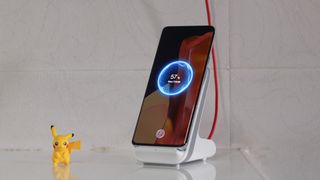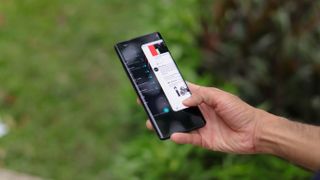DxOMark announces a new battery experience test for smartphones
The #1 rank will not surprise anyone

Smartphones are extremely complex machines, and the marketing by OEMs only makes matters worse for consumers. This is why third-party testing and verification is becoming increasingly important. With an aim to bring some objectivity to the mix, DxOMark has launched a new smartphone battery experience score.
DxOMark has been quickly adding more protocols to its portfolio. While its camera tests are the most popular, it recently also expanded to displays and audio for smartphones. Now, the French company is expanding to battery testing to help consumers understand how a smartphone will fare before buying.
The DxOMark Battery protocol tests over 100 parameters and takes into account 70 measurements, for a process that can take up to 150 hours. It aims to replicate how most people use and charge their phone throughout the day to make the findings more accurate and relatable for consumers. It also serves as a guideline for smartphone makers on how to improve the battery experience on their offerings.
The DxOMark battery score is determined by three factors. These help break down how a smartphone will actually fare in real-life usage, as opposed to basing expectations on specs such as the battery capacity of charging wattage.
Autonomy

The autonomy tests check a variety of common use cases to understand power consumption and thus, battery longevity. It starts with placing the smartphone inside a Faraday cage (to reduce network fluctuation side effects) and using robots to do the same set of tasks, such as calls, scrolling through social media, gaming, web browsing, playing videos and music, etc. for four hours — which is the global average daily screen-on time for users (FYI: the number is much higher in India). The test is repeated for multiple days, spread between 7 am and 11 pm, and all the stats are constantly noted, till the phone runs out of power.
For the next set of tests, the device is taken outdoors on a set route, where an engineer will systematically make calls, check social apps, take photos and videos, use GPS navigation, and stream music, while using different modes of commute such as walking, bus and subway, to understand how a smartphone reacts to varying levels of network reception.
Lastly, the phone will be tested in a very calibrated environment, where all variables are controlled, and the battery is drained all the way from 100 to 0 for the same tests. The brightness is set to 200 nits, the sound output is set to 60 dB at 10 cm and a stable Wi-Fi connection is used to bring further uniformity.
Get daily insight, inspiration and deals in your inbox
Get the hottest deals available in your inbox plus news, reviews, opinion, analysis and more from the TechRadar team.
Charging

With fast charging becoming increasingly common, the DxOMark battery test also takes into consideration how much time a phone takes for a full charge, how much power can be added in short bursts of 5 minutes at various pre-determined levels, disparity between 100% on the UI vs. 100% on the battery, etc.
Efficiency

To round things off, the last set of tests measure the efficiency of the entire power management system using an oscilloscope to understand how much energy is required for a full charge vs. the capacity of the battery, residual power consumption at an idle state, and software-based optimizations to get the highest backup out of the available battery.
How the score is calculated

After all the tests are done and individual scores are obtained, an overall “global” score is calculated by assigning weights to the parameters — 50% for autonomy, 33% for charging and 17% for efficiency.
All the smartphones are then ranked to highlight which is most likely to give the best battery experience to users. To further aid consumers, three additional “stickers” are provided, which show how long the device lasted in the battery test, time taken for an 80% charge and time taken for a full charge where the phone stops drawing power from the outlet.
Currently, the Samsung Galaxy M51 tops the DxOMark smartphone battery rankings with an overall score of 88 points (96 autonomy, 61 charging, 87 efficiency). TechRadar’s Samsung Galaxy M51 review corroborates these findings as it continues to be the phone with the best battery life that we’ve ever tested.
Battery performance depends on a combination of factors including the choice of hardware components and power management software optimization. Using our score centred on the end-user, we aim to guide consumers in their purchasing decisions.
Olivier Simon, Battery Evaluation Direct
Apart from helping consumers, the findings also help manufacturers understand how they can provide a better battery experience. Usually, it is not possible to offer a larger battery due to space constraints, and charging standards are now always easy to ramp up. Olivier Simon, the battery testing director at DxOMark tells us that improving the efficiency has the highest impact on the overall experience in a practical way, even if it might be difficult to optimize the software and hardware.
While the battery test is very comprehensive, there are some shortcomings that aren’t taken into consideration. Network reception high varies between regions and providers, which can have an impact on cellular power consumption. Secondly, high-end smartphones will inherently consume more power due to their chipsets. This puts them at a disadvantage for instances such as gaming as they will run at higher graphics and framerates than budget devices.
Every phone is tested at the default settings, so a phone with a higher resolution, higher refresh rate display will have the odds stacked against itself, even if it provides a better user experience. Battery health and degradation is also not taken into account, as that is usually the biggest factor for bad battery life over a period of time — though it needs to be noted that it is physically impossible to test battery degradation and the implications of charge cycles in a shorter period of time.
- Samsung Galaxy M51 review
- DxOMark announces a new Display test and updates its Camera scoring system
- The best phones in India for 2021
Want to know about the latest happenings in tech?
Follow TechRadar India on <a href="https://twitter.com/TechRadarIndia" data-link-merchant="twitter.com"" target="_blank">Twitter, <a href="https://www.facebook.com/TechRadarIndia" data-link-merchant="facebook.com"" data-link-merchant="twitter.com"" target="_blank">Facebook and <a href="https://www.instagram.com/techradarindia/" data-link-merchant="instagram.com"" data-link-merchant="facebook.com"" data-link-merchant="twitter.com"" target="_blank">Instagram!
Aakash is the engine that keeps TechRadar India running, using his experience and ideas to help consumers get to the right products via reviews, buying guides and explainers. Apart from phones, computers and cameras, he is obsessed with electric vehicles.


